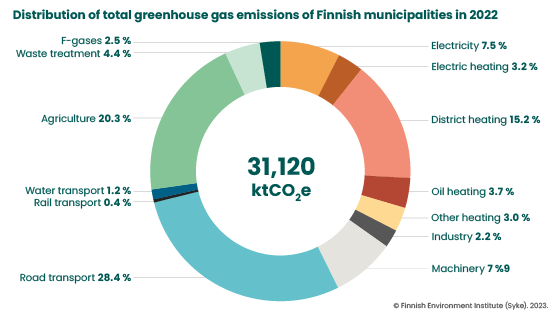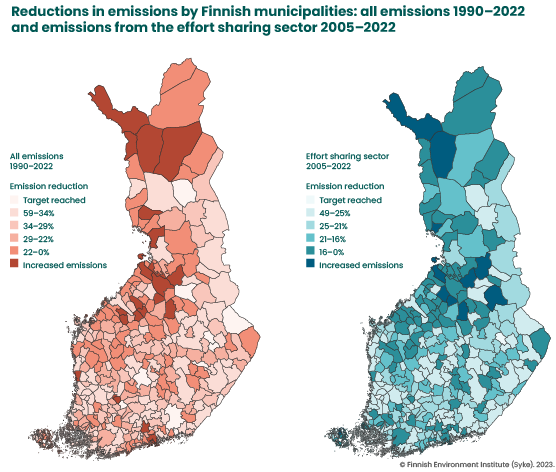
The greenhouse gas emissions of Finnish municipalities by sector in 1990 and 2005–2022. The emissions have been calculated in accordance with the Hinku calculation rules, without carbon offsets. © Syke
According to the Finnish Environment Institute (Syke), municipalities’ total greenhouse gas emissions in 2022 fell by 2.7 per cent from the previous year. Compared to 2005, emissions have decreased by 29.6 per cent. As in previous years, the largest sources of greenhouse gas emissions in 2022 were road transport (28.4% of total emissions), agriculture (20.3%) and the production of district heating (15.2%).
The results of 2022 reflect the effects of Russia's war of aggression against Ukraine. This was particularly evident in the energy sector, where the emission intensity of district heat production increased slightly. As a result of the war in Ukraine, the use of natural gas and wood fuels was partly replaced by coal and peat. Greenhouse gas emissions from district heat production increased by about 2.3 per cent despite the reduction in energy consumption.
Emissions from electricity use continued to decrease. This was positively influenced by the reduction in energy consumption. Although the use of coal grew, the increase in wind power generation reduced the emission intensity of electricity production.
Road transport had a positive emission development from the electrification of the vehicle fleet and the decrease in mileage, that is, the number of kilometres driven. On the other hand, the biocomponent content in fuels was lower than in the previous year, which increased greenhouse gas emissions. According to preliminary data, road transport emissions increased slightly from the previous year, but remained below the 2020 emission level.
Emissions from other separate heating of buildings (oil, gas, wood) continued their downward trend. Emissions from waste treatment decreased by 5 per cent, and emissions from fluorinated greenhouse gases by 8.5 per cent. Similarly, emissions also decreased in the smallest sectors, rail and water transport. Agricultural emissions lowered by less than one per cent from the previous year.
“In 2022, the series of exceptional global adverse events was continued with the war in Ukraine, the effects of which were reflected in several emissions sectors. Although the 2022 data show some setbacks compared to previous emission trends, more positive developments can be expected in the future, especially in the energy sector,” says Santtu Karhinen, Senior Research Scientist in charge of calculations at Syke.

Distribution of total greenhouse gas emissions of Finnish municipalities in 2022. The emissions have been calculated in accordance with the Hinku calculation rules, without carbon offsets. © Syke
Significant further efforts needed in most municipalities to achieve national climate targets
In connection with the publication of the preliminary estimates for 2022, municipality-specific emissions data for 1990 were also added to the emission data service (paasto.hiilineutraalisuomi.fi/). The service provides monitoring in accordance with the Hinku calculation rules, as well as the total emissions of different areas, separated into emissions trading and the effort sharing sector.
Area-based emissions from 1990 make it possible to compare the emission reduction rate of the areas in relation to the national targets in 2030 (-60%), 2040 (-80%) and 2050 (-90-95%). In the effort sharing sector, Finland's emissions reduction target is -50 per cent in 2005–2030.
Between 1990 and 2022, total emissions have decreased by 35.9 per cent, and in the effort sharing sector by around 22.1 per cent between 2005 and 2022. As is the case with the implementation of active climate work, there are clear regional differences in the pace of emission reduction. The differences relate to demographic and geographical characteristics, as well as changes in the economic structure, among other things.
Comparative data show that significant additional efforts are needed in most municipalities to achieve national targets. Further efforts are needed in the energy consumption of buildings and industry, but also, in particular, to reduce emissions from road transport and agriculture.

The maps reflect how close or far Finland's different municipalities were from their national emission reduction targets in terms of total emissions and emissions from the effort sharing sector in 2022. The map on the left illustrates the total emissions of municipalities, with the reference year being 1990. The map on the right illustrates emissions from the effort sharing sector, such as agriculture and transportation, in municipalities, with the reference year being 2005. © Syke
Emissions calculation materials are publicly available:
Emissions data
Methodology of emissions calculation
Report: The calculation of Finnish municipal greenhouse gas emissions, with a description of the methodology of the ALas model and calculations from 2005 to 2018 (in Finnish)
Greenhouse gas emissions scenario tool for municipalities (in Finnish)
Additional information
Santtu Karhinen, Senior Research Scientist, Finnish Environment Institute, tel. +358 29 525 1889, firstname.lastname@syke.fi
Jari Rantsi, Coordinator, Finnish Environment Institute, tel. +358 29 525 1274, firstname.lastname@syke.fi
Eija Ferreira, Senior Research Scientist (oil and other separate heating), Finnish Environment Institute, tel. +358 29 525 227, firstname.lastname@syke.fi
Juha Grönroos, Senior Research Scientist (Agriculture), Finnish Environment Institute, tel. +358 29 525 1128, firstname.lastname@syke.fi
Tommi Forsberg, Coordinator (F-gases), Finnish Environment Institute, tel. +358 29 525 1116, firstname.lastname@syke.fi